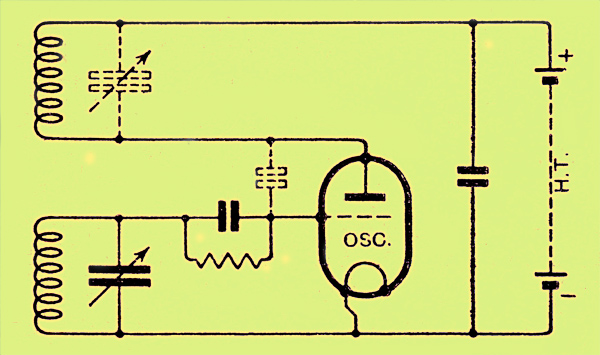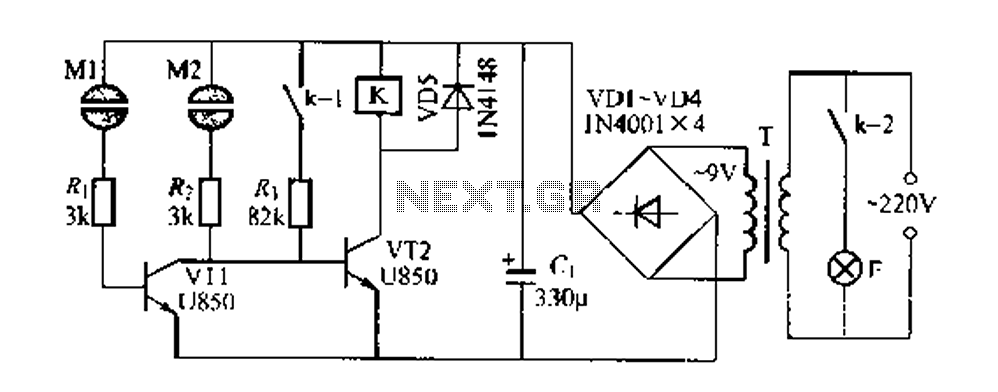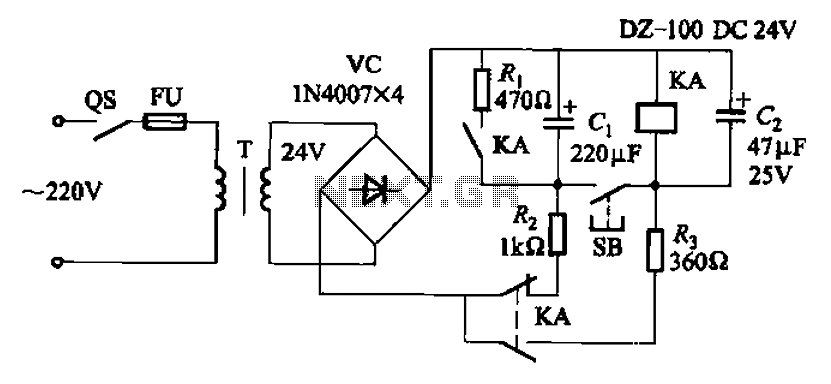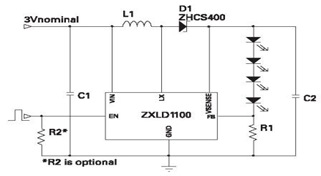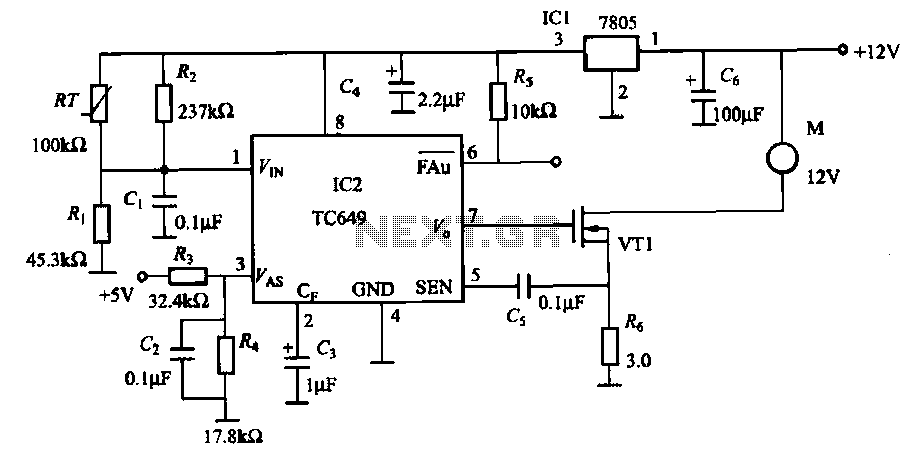
Narrow pulse infrared light emitting circuit
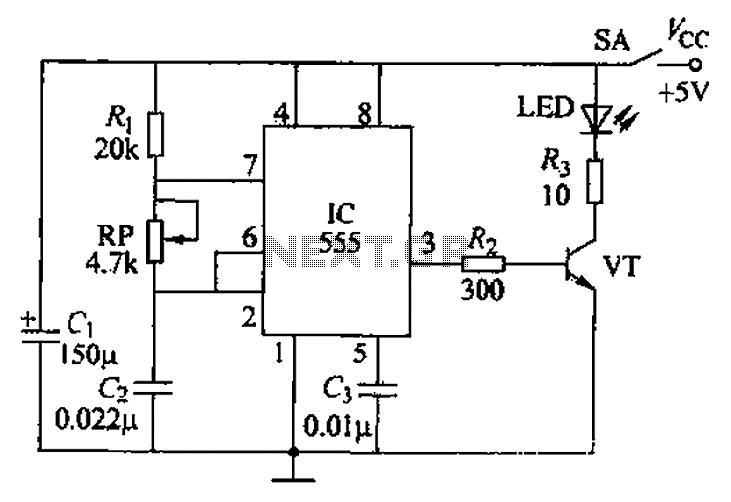
The circuit utilizes a 555 timer integrated circuit along with a transistor (VT) and several external components to create a multivibrator circuit. The charge and discharge time constants, Ti and T2, are defined, where Ti is approximately 0.7 times the resistance of a potentiometer (RP), and T2 is similarly defined. The oscillation frequency of the circuit is dependent on the charge and discharge time constants, calculated as T = Ti + T2. The frequency can be adjusted using the potentiometer RP to meet specific requirements, such as achieving a frequency range of 18-54 mesh parameters, which corresponds to an oscillation frequency of about 20 kHz. The charging time constant (Ri + RP) is significantly larger than the discharge time constant (R2 C2), resulting in a low to high pulse output ratio of approximately 1:10. The driver stage employs an NPN transistor (3DG6), which facilitates the conduction of an infrared LED, allowing it to emit infrared light during its active phase. The red LED is only active for 1/10 of the oscillation period, producing narrow pulses of infrared light. The infrared LED used is a TLN107 diode, capable of handling a peak current of 600 mA, with an average current of around 250 mA. The LED is equipped with a lens that focuses the emitted infrared light into a beam with a radiation angle of 50 to 60 degrees, effectively transmitting infrared signals to a receiver.
The described circuit operates as a pulse generator utilizing the 555 timer in astable mode. The configuration includes a resistor (Ri) connected to the discharge pin of the 555 timer, and a potentiometer (RP) that allows for frequency modulation. The second resistor (R2) and capacitor (C2) are critical in determining the discharge time constant, influencing the duty cycle of the output waveform.
The output from the 555 timer is fed into the base of the NPN transistor (3DG6), which acts as a switch to control the infrared LED. The transistor amplifies the output signal from the 555 timer, enabling the LED to emit pulses of infrared light with a specified duty cycle. The design ensures that the LED operates efficiently, with the peak current being within the safe operating limits of the component.
The lens attached to the TLN107 infrared LED is designed to collimate the emitted light into a narrow beam, enhancing the effective range of the infrared signal. This configuration is particularly useful in applications where precise infrared communication is required, such as remote controls or data transmission systems.
In summary, the circuit is a versatile and adjustable infrared pulse generator, capable of emitting modulated infrared signals at a frequency of approximately 20 kHz, with the ability to fine-tune the output characteristics through the use of external components. By the time-base integrated circuit 555, the transistor VT and a few external components to form a multivibrator circuit charge and discharge time constant Ti and V, where Ti 0 .7 (stone roller + RP) Island, T2 a 0. 7RPCz, its oscillation frequency depends on the charge and discharge time constant T (T Ti + hole), that is., I-l/D-1. d4/[(Rl + 2RP) (12] RP Hr potentiometer to adjust the frequency of the oscillation circuit according to needs, such as 18-54 mesh parameter, the oscillation frequency is about 20kHz.
Since the charging time constant (Ri + RP ) (the soil is much larger than the discharge time constant R2 C2 Therefore, the pin output low and high pulse oscillation time than about 1: 10. VT due to driver stage using an NPN transistor 3DG6, so-infrared LED conduction emission) and suspended off time ratio of 1 t 10.
that red is only 1/10 of the oscillation period T outer tube emitting infrared light emission time, a narrow pulse is emitted infrared light. infrared light emitting diode LED using TLN107 diode, a peak current of 600rnA, the average level of about 250mA.
top LED has a lens, it will emit infrared light converging into radiation angle of 50. to 60. radiate infrared beam, as infrared signals sent to the receiver number.
The described circuit operates as a pulse generator utilizing the 555 timer in astable mode. The configuration includes a resistor (Ri) connected to the discharge pin of the 555 timer, and a potentiometer (RP) that allows for frequency modulation. The second resistor (R2) and capacitor (C2) are critical in determining the discharge time constant, influencing the duty cycle of the output waveform.
The output from the 555 timer is fed into the base of the NPN transistor (3DG6), which acts as a switch to control the infrared LED. The transistor amplifies the output signal from the 555 timer, enabling the LED to emit pulses of infrared light with a specified duty cycle. The design ensures that the LED operates efficiently, with the peak current being within the safe operating limits of the component.
The lens attached to the TLN107 infrared LED is designed to collimate the emitted light into a narrow beam, enhancing the effective range of the infrared signal. This configuration is particularly useful in applications where precise infrared communication is required, such as remote controls or data transmission systems.
In summary, the circuit is a versatile and adjustable infrared pulse generator, capable of emitting modulated infrared signals at a frequency of approximately 20 kHz, with the ability to fine-tune the output characteristics through the use of external components. By the time-base integrated circuit 555, the transistor VT and a few external components to form a multivibrator circuit charge and discharge time constant Ti and V, where Ti 0 .7 (stone roller + RP) Island, T2 a 0. 7RPCz, its oscillation frequency depends on the charge and discharge time constant T (T Ti + hole), that is., I-l/D-1. d4/[(Rl + 2RP) (12] RP Hr potentiometer to adjust the frequency of the oscillation circuit according to needs, such as 18-54 mesh parameter, the oscillation frequency is about 20kHz.
Since the charging time constant (Ri + RP ) (the soil is much larger than the discharge time constant R2 C2 Therefore, the pin output low and high pulse oscillation time than about 1: 10. VT due to driver stage using an NPN transistor 3DG6, so-infrared LED conduction emission) and suspended off time ratio of 1 t 10.
that red is only 1/10 of the oscillation period T outer tube emitting infrared light emission time, a narrow pulse is emitted infrared light. infrared light emitting diode LED using TLN107 diode, a peak current of 600rnA, the average level of about 250mA.
top LED has a lens, it will emit infrared light converging into radiation angle of 50. to 60. radiate infrared beam, as infrared signals sent to the receiver number.

